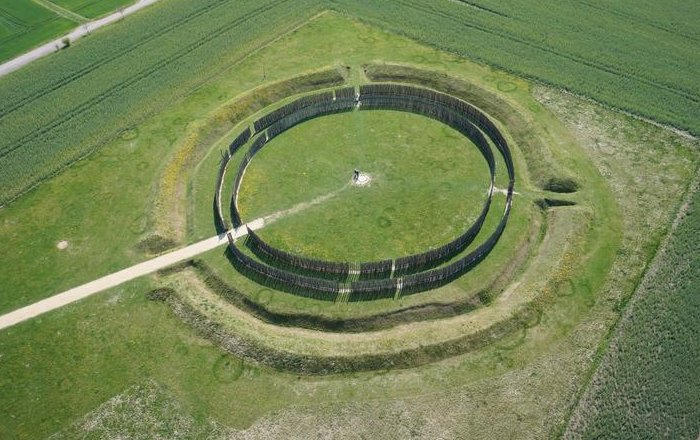Conny Waters – AncientPages.com – Around 150 so-called circular enclosures are known from the Central and Eastern European Middle Neolithic (first half of the 5th millennium BCE). Only a few of them have been extensively and systematically archaeologically examined.

Aerial view of the Middle Neolithic circular enclosure of Goseck. State Office for Heritage Management and Archaeology Saxony-Anhalt
The function of these large buildings is still discussed intensively. The Goseck Middle Neolithic circular enclosure (Stichbandkeramik culture, ca. 4900 to 4600/4550 BCE) was completely excavated within a cooperation project of the State Office for Heritage Management and Archaeology Saxony-Anhalt and the Martin-Luther-University in Halle-Wittenberg and is now comprehensively published. It offers new evidence for a sacred and astronomical interpretation.
From the Central and Eastern European Middle Neolithic (first half of the 5th millennium BCE), around 150 so-called circular enclosures are known, circular or elliptical roughly concentric arrangements of ditches and palisades with a diameter between 40 an up to 250 m. Only a few have been comprehensively and systematically examined archaeologically. The function of these large buildings is still discussed intensively. Interpretations such as central places for meetings, cattle enclosures, defensive structures, astronomical observatories or spaces for ritual activities have been proposed. The recent publication of the research results from the completely excavated circular enclosure of Goseck, Burgenlandkreis, Saxony-Anhalt by Dr. Norma Henkel brings forward new evidence for the interpretation of these still enigmatic constructions.
The Goseck Middle Neolithic circular ditch (Stichbandkeramik culture, approx. 4900 to 4600/4550 BCE) was discovered in 1991 by Otto Braasch during aerial archaeological investigations. Between 2002 and 2004 it was completely excavated within a cooperation project between the State Office for Heritage Management and Archaeology Saxony-Anhalt (LDA) and the Martin-Luther University Halle-Wittenberg (MLU). The spectacular results of the excavations led to the decision to completely rebuild the complex on site – it has been open to the public since 2005. Between 2005-2013, a large-scale project led by Prof. Dr. François Bertemes (MLU) followed, which analyzed the setting of the circular enclosure within the contemporaneous settlement landscape.
The Goseck circular enclosure is composed of a ditch, possibly a rampart in front of it and two concentric palisade wreaths that delimit the interior of the complex. It had three entrances: in the north, south-east and south-west. Numerous pits were found both inside and outside the construction, most of which contained animal bones and pottery. Numerous findings point to a sacred function of the building.
In the area of the circular ditch, fragments of cattle skulls came to light in a strikingly high frequency; additionally, about 30 horn cores from cattle were found. Cattle are also by far the most frequently represented species in the animal bone spectrum of the circular enclosure. A special importance and symbolic meaning of cattle is evident for many Neolithic cultures.
In the south-eastern area, the outer palisade cuts a pit measuring approximately 1.6 m by 1.3 m. The pit is unusual for several reasons. Its walls were severely burned. Pits with traces of fire can be found in Goseck at various locations in the circular ditch system. In addition to the burn marks, this pit contained human bones from an adult individual. Only parts of the extremities were found, bones from the torso or the skull were missing. Since the bones were no longer in an anatomical composition, it can be ᴀssumed that they were deposited in a partially skeletonized state. Another pit contained five phalanges and metacarpal bones from a human right hand. The bones were deposited in anatomical composition and belonged to a juvenile/adult male.
In addition to these findings, astronomical references point to a sacred function of the circular enclosure. From a location roughly in the center of the building, the sunrise and sunset of important astronomical events could be precisely predicted and observed to within a few days.
The most important lines of sight pᴀss through the two culverts in the south-east and south-west. Only here are the openings in the palisade reflected in the circular ditch. They correspond to the rising and setting points of the sun on the winter solstice (December 21). Other pᴀssages in the palisade point to the summer solstice (June 21) and Beltaine (April 30).
Orignal source
Written by Conny Waters – AncientPages.com Staff Writer





